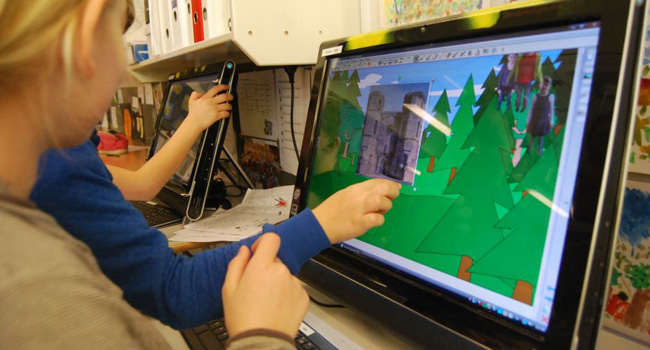Jacob Davidsen: Second graders’ collaborative learning around touchscreens in their classroom: Micro-studies of eight and nine year old children’s embodied collaborative interactions in front of a touchscreen
In this thesis, I explore, analyse and discuss how eight- and nine-year-old children’s embodied collaborative interactions around touchscreens unfold. Having conducted micro-studies on children’s embodied collaborative interactions around touchscreens, I have found that children’s body movements and, in particular, their hand movements, are crucial for their collaborative activities around touchscreens. The data comprise 150 hours of video footage and ethnographic observations, all from a yearlong study of naturally occurring activities in two different second grade classrooms at a public school in Denmark.
The thesis is paper based, meaning that it contains two separate parts: Part 1, in which I present the outcome of my research, first as a portrait of my research journey, and then as a summary of my findings and their scientific validity; and Part 2 – a separate publication – which contains five research papers selected as the most significant presentations of my work. The five papers are micro-studies of children’s embodied collaborative interactions, which, among other things, shows how I have developed my method of working with video footage, the process and product of transcription, representation and analysis of video recordings of naturally occurring, embodied collaborative interactions.
My research concerns seeing and making visible what children do around touchscreens—or, more precisely, how children do what. In this endeavour, I am informed by computer-supported collaborative learning (CSCL), ethnomethodology (Garfinkel, 1967) and embodied interaction analysis (Streeck, Goodwin, & LeBaron, 2011b). This way of seeing and making visible children’s embodied collaborative interactions around touchscreens stands in contrast to the main body of related research on collaboration and touch technology, in which research findings are based on coding and on counting children’s interactions. While such studies provide knowledge about behaviour on a general level, my way-of-seeing and making-visible provides knowledge about the moment-to-moment embodied meaning-making unfolding around the touchscreen. The difference between knowledge of behaviour and knowledge of embodied meaning-making, which I outline in Part 1, has implications for politicians’ decisions regarding technology investments in schools, as well as their decisions regarding the ways in which outcomes of collaborative learning are to be tested and measured. More concretely, in teachers’ education, as well as in the everyday professional lives of teachers (as I show in Papers III and IV), it is important to know the difference between knowledge of behaviour and knowledge of embodied meaning-making when it comes to learning and interaction with digital technologies.
I see my research as part of the field of CSCL, where my micro-studies contribute findings regarding children’s embodied practices of moment-to-moment co-operation of collaborative activities around touchscreens.







